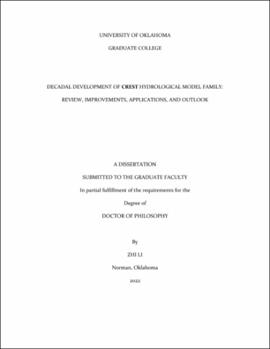| dc.description.abstract | A hydrological model is an indispensable tool in Earth system science and engineering operations to understand, predict, and manage water resources on Earth. The Coupled Routing and Excess Storage (CREST) model, released in 2011, is one such to simulate distributed hydrologic states and fluxes at variable scales. Over the last decade, CREST model has been actively under development and applied by different sectors to tackle water-related problems worldwide. This dissertation is dedicated to expanding the capacity of CREST model from three main fronts: (1) hydrologic data, (2) model development, and (3) applications. To start, the decadal development and applications of CREST model family were reviewed to lay the foundation for my contribution (Chapter 1). First, uncertainties in hydrologic input data were evaluated comprehensively for three state-of-the-science precipitation datasets derived from in-situ instruments, ground weather radar, and satellites during extreme events (Chapter 2); then a 120-year CONUS-wide flood database was compiled into a unified format as a validation source for models and hydroclimatic research (Chapter 3). From the model development front, a Hydrologic&Hydraulic (H&H) framework was developed to empower flood inundation mapping capacity for CREST (Chapter 4); furthermore, the re-infiltration, an important yet often ignored hydrologic process during the flooding period, was incorporated to improve the more realistic rainfall-runoff modeling representation (Chapter 5). To further improve the model efficiency, a vector-based CREST model was developed that can achieve 10x speedup for a continental-scale simulation, as well as improved model accuracy (Chapter 6). Finally on the model application, the high-resolution CREST model was applied in quantifying future US floods in a warmer climate: flood flashiness is becoming 7.9% higher for the continent (Chapter 7); and extreme rainfall and floods are becoming more frequent, widespread, and less seasonal (Chapter 8). The final Chapter 9 summarizes the contributions to the CREST model family development, outlooks, and general remarks for advancing our understanding of hydrologic science and engineering. | en_US |

